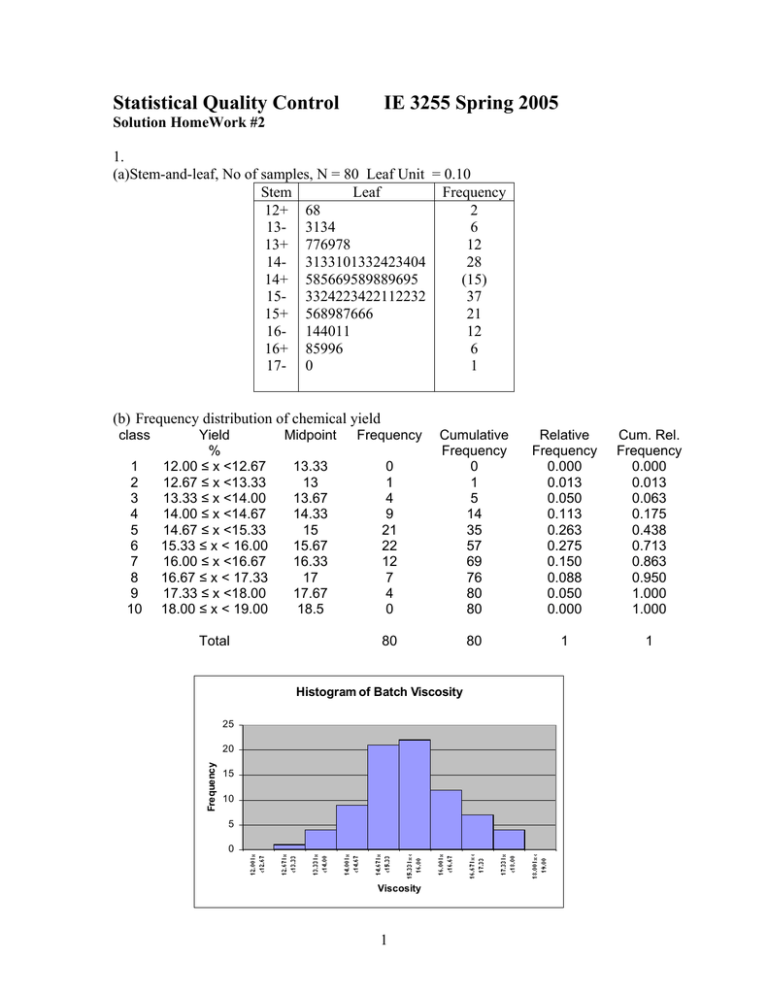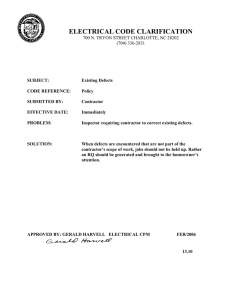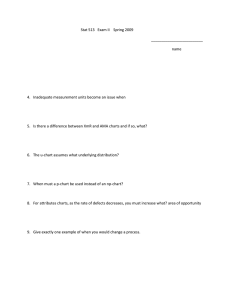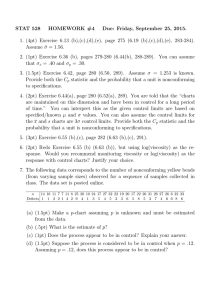Statistical Quality Control Homework Solution
advertisement

Statistical Quality Control
IE 3255 Spring 2005
Solution HomeWork #2
1.
(a)Stem-and-leaf, No of samples, N = 80 Leaf Unit = 0.10
Stem
Leaf
Frequency
2
12+ 68
6
13- 3134
12
13+ 776978
28
14- 3133101332423404
(15)
14+ 585669589889695
37
15- 3324223422112232
21
15+ 568987666
12
16- 144011
6
16+ 85996
1
17- 0
(b) Frequency distribution of chemical yield
1
2
3
4
5
6
7
8
9
10
Yield
%
12.00 ≤ x <12.67
12.67 ≤ x <13.33
13.33 ≤ x <14.00
14.00 ≤ x <14.67
14.67 ≤ x <15.33
15.33 ≤ x < 16.00
16.00 ≤ x <16.67
16.67 ≤ x < 17.33
17.33 ≤ x <18.00
18.00 ≤ x < 19.00
Total
Midpoint
Frequency
0
1
4
9
21
22
12
7
4
0
Cumulative
Frequency
0
1
5
14
35
57
69
76
80
80
Relative
Frequency
0.000
0.013
0.050
0.113
0.263
0.275
0.150
0.088
0.050
0.000
Cum. Rel.
Frequency
0.000
0.013
0.063
0.175
0.438
0.713
0.863
0.950
1.000
1.000
13.33
13
13.67
14.33
15
15.67
16.33
17
17.67
18.5
80
80
1
1
Histogram of Batch Viscosity
25
20
Frequency
class
15
10
5
0
Viscosity
1
The shape of the histogram is not symmetric, and there appear to be one location of
central tendency. The distribution does resemble normal probability distribution.
(c)Stem-and-leaf, No of samples, N = 80 Leaf Unit = 0.10
Stem
Leaf
Frequency
2
12+ 68
6
13- 1334
12
13+ 677789
28
14- 0011122333333444
(15)
14+ 555566688889999
37
15- 1122222222333344
21
15+ 566667889
12
16- 011144
6
16+ 56899
1
17- 0
Median observation rank is (0.5)(N) + 0.5 = (0.5)(80) + 0.5 = 40.5
X0.50 = (14.9 + 14.9)/2 = 14.9
Q1 observation rank is (0.25)(N) + 0.5 = (0.25)(80) + 0.5 = 20.5
Q1 = (14.3 + 14.3)/2 = 14.3
Q3 observation rank is (0.75)(N) + 0.5 = (0.75)(80) + 0.5 = 60.5
Q3 = (15.6 + 15.5)/2 = 15.55
(d)
10th percentile observation rank = (0.10)(N) + 0.5 = (0.10)(80) + 0.5 = 8.5
X0.10 = (13.7 + 13.7)/2 = 13.7
90th percentile observation rank = (0.90)(N) + 0.5 = (0.90)(80) + 0.5 = 72.5
X0.90 = (16.4 + 16.1)/2 = 16.25
(e)
Box plot for the chemical process
14.3
14.9
12.6
15.55
17.0
2
2. Consider the viscosity data in Exercise 1. Construct a normal probability plot, a
lognormal probability plot, and a Weibull probability plot for these data. Based on
the plots, which distribution seems to be the best model for the viscosity data?
3
4
3. A mechatronic assembly is subjected to a final functional test. Suppose that defects
occur at random in these assemblies, and that defects occur according to a Poisson
distribution with parameter λ = 0.02.
(a) What is the probability that an assembly will have exactly one defect?
(b) What is the probability that an assembly will have one or more defects?
(c) Suppose that you improve the process so that the occurrence rate of defects is cut in
half to λ = 0.01. What effect does this have on the probability that an assembly will
have one or more defects?
Solution
This is a Poisson distribution with parameter λ = 0.02, x ~ POI(0.02).
(a)
e −0.02 (0.02) 1
Pr{ x = 1} = p (1) =
= 0.0196
1!
(b)
e −0.02 (0.02) 0
0!
= 1 - 0.9802 = 0.0198
Pr{ x ≥ 1} = 1 − Pr{ x = 0} = 1 − p (0) = 1 −
(c) Poisson distribution with parameter λ = 0.01, x ~ POI(0.01).
e −0.01 (0.01) 0
Pr{x ≥ 1} = 1 − Pr{x = 0} = 1 − p (0) = 1 −
0!
= 1 - 0.9900 = 0.0100
Cutting the rate at which defects occur reduces the probability of one or more defects
approximately half, from 0.0198 to 0.0100.
5
4. A production process operates with 2% nonconforming output. Every hour a sample
of 50 units of product is taken, and the number of nonconforming units counted. If
one or more nonconforming units are found, the process is stopped and the quality
control technician must search for the cause of nonconforming production. Evaluate
the performance of this decision rule.
Solution
This is a binomial distribution with parameter p = 0.02 and n = 50. The process is
stopped if x ≥ 1.
⎛ 50 ⎞
Pr{x ≥ 1} = 1 − Pr{x < 1} = 1 − Pr{x = 0} = 1 − ⎜⎜ ⎟⎟(0.02) 0 (1 − 0.02) 50−0 = 1 − 0.364 = 0.636
⎝0⎠
The decision rule means that 63.6% of the samples will have one or more nonconforming
units, and the process will be stopped to look for a cause. This is a somewhat difficult
operating situation. It will cost the company a lot on down time.
6
5. An inspector is looking for nonconforming welds in the gasoline pipeline between
Phoenix and Tucson. The probability that any particular weld will be defective is
0.01. The inspector is determined to keep working until finding three defective
welds. If the welds are located 100 ft apart, what is the probability that the inspector
will have to walk 5000 ft? What is the probability that the inspector will have to walk
more than 5000 ft?
6. A population has a mean µ of 44.3 and a standard deviation σ of 2.1.
(a) Analyze the problem with a sketch of the normal curve.
(b) What percentage of the measurements is larger than 46?
(a)
b. P{x > 46} = 1 - P{x < 46}
= 1 - P{x < 46}
46 - 44.3
= 1 - P{z <
}
2.1
= 1 − Φ (0.8095)
= 1 − 0.79103
= 0.20897 = 20.9%
7
7. An electronic component in an automobile has a useful life described by an
exponential distribution with failure rate 10-5/h.
(a) What is the mean time to failure for this component?
(b) What is the probability that this component would fail before its expected life.
(c) If failure rate is 10-8/h,compute the probability that the component would fail before
its expected life.
(d) Compare results from (b) and (c).
Solution
(a)
This is exponential distribution with parameter λ = 10-5
Mean time failure rate = 1/λ = 105 = 10,0000 hours
(b) Probability that this component would fail before its expected life.
1/ λ
⎧
1⎫
P ⎨ x ≤ ⎬ = ∫ λe − λt dt = 1 − e −1 = 0.6321
λ⎭ 0
⎩
(c) If failure rate, λ = 10-8 , probability that this component would fail before its expected
life becomes
1/ λ
⎧
1⎫
P ⎨ x ≤ ⎬ = ∫ λe − λt dt = 1 − e −1 = 0.6321
λ⎭ 0
⎩
(d) Comparing b and c, one concludes that the probability that a value of an exponential
random variable will be less than its mean is 0.63212, regardless of the value of λ.
8




